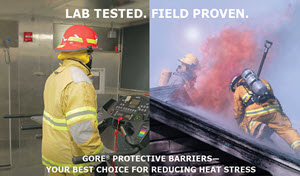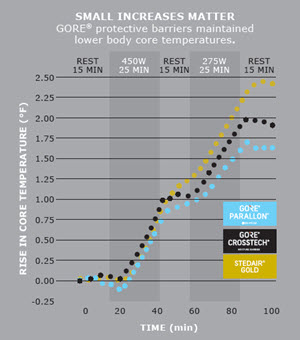
A group of firefighters wearing turnout gear completed a defined
work/rest cycle in a controlled environment as their body core
temperatures, heart rates, and skin temperatures were monitored.
Over a period of several weeks, the same participants repeated the
trial three times so they could wear each set of gear containing one
of the three different protective barriers. And, the results were
exceptional.
PROVEN IN HUMAN STUDY CONDUCTED BY A THIRD PARTY
* The GORE® PARALLON™ liner system and the GORE® CROSSTECH® black moisture barrier
delivered the highest breathability — significantly better than the competition.
* All of the firefighters were able to complete the trial while wearing gear with GORE® protective
barriers; on the contrary, 40 percent could not finish the test when wearing the competitive
barrier because their heart rates exceeded their maximum rates established prior to the trial.
* RET results directly correlated with the participants’ physiological responses, whereas THL did not.
INCREASE IN BODY CORE TEMPERATURE
U.S. military research has shown that once a body core temperature
of 100°F is reached, each increase of only 0.1°F is physiologically
significant, leading to an increased risk of heat exhaustion. At the
end of the human trial, the average increase of body core temperature
varied depending on the protective barrier in the gear. The GORE®
PARALLON™ liner system performed the best, followed closely by
the GORE® CROSSTECH® black moisture barrier; however, the increase
with the competitive barrier was the largest.
RESPONSE TO WORK/REST CYCLE
Rest cycles are crucial to enable your body to recover from the
strain of the challenging environments in which you work. When
the participants were wearing the GORE® PARALLON™ liner system
or GORE® CROSSTECH® black moisture barrier, the rest periods
were more effective; when they wore the competitive barrier, their
temperatures continued to rise rapidly. In fact, 40 percent of them
were pulled out during the second work cycle because their heart
rates exceeded their maximum rates, which were established
before the trial began.
RET (RESISTANCE TO SWEAT EVAPORATION) VERSUS THL (TOTAL HEAT LOSS)
Testing the performance of the materials in your gear can provide
valuable information for gear selection. The THL test has done a
great deal of good for the firefighter, helping to improve how well
gear can shed excess body heat; but it evaluates performance in a
relatively mild environment, similar to a conditioned office space.
And, it has been found that THL does not provide very useful
information about how gear performs, particularly in warm or sunny
conditions. The RET test can provide some of this valuable insight,
which could be important to you in your gear selection.
Before the trial began, each turnout gear composite was measured
for THL and RET. While THL did not predict the differences seen in
the human trials, the RET testing did. In fact, the THL results, which
are what is commonly available to fire departments today, indicated
that there should be NO difference in performance between the gear
tested in this study. However, the trial confirmed that there were
significant differences—the Gore technologies were more breathable
and had a lower burden on the firefighters, as demonstrated by lower
core temperatures, lower skin temperatures, and lower heart rates.



